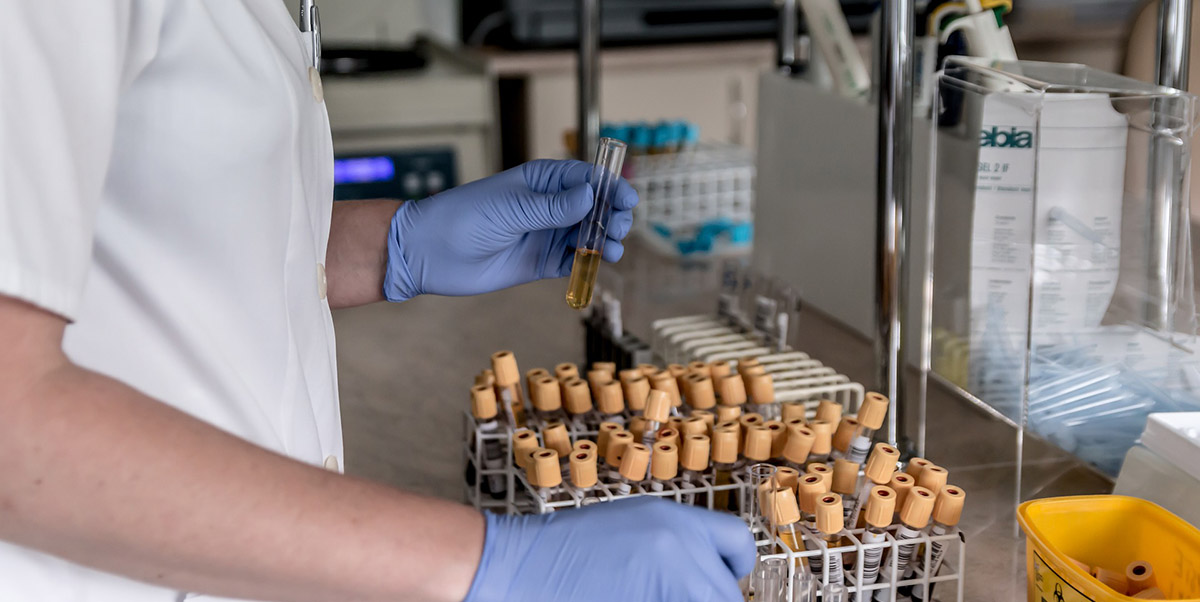This webinar reviews the principles-based guidelines of ASC 606 and highlights the potential impact within the healthcare industry.
Category: For Laboratories
Mitigate Prior Authorization Challenges: A Guide to Best Practices
This white paper will provide a guide to implementing a successful prior authorization strategy for clinical laboratories.
14 Day Rule Regarding ADLT and MolPath Tests Continues to Show Movement
Movement continues on CMS reimbursement of Advanced Diagnostic Laboratory Tests (ADLTs) and Molecular Pathology testing during the 14 days following a hospital stay.
Recently it was announced that CMS will exercise enforcement discretion until January 2, 2019, for the laboratory date of service (DOS) exception policy for ADLTs and molecular pathology tests excluded from Hospital Outpatient Prospective Payment System (OPPS) packaging policy.
If you are a performing laboratory prepared to bill Medicare directly for ADLTs and molecular pathology tests subject to the new laboratory DOS exception, this enforcement discretion period does not prevent you from doing so before January 2, 2019. However, in no case should both the hospital and the performing laboratory bill for the same test for the same beneficiary.
Labs that have billed tests under the DOS exception and experienced denials, including where Medicare is secondary, may want to contact their Medicare Administrative Contractor (MAC) for further direction on these claims.
The policy may be found here.
For a brief overview of the Medicare Hospital Outpatient Prospective Payment System (OPPS) and revisions for 2018, you can check out this blog post.
Prior Authorization – The Lab’s Dilemma
How are some of the payers’ Prior Authorization (PA) programs impacting your laboratory’s bottom line and what can you do about it? Increasingly, retroactive authorization after performing lab tests is becoming a less viable option; as is fighting denials for lack of Prior Authorization during the appeal process. While some payers still allow retroactive authorization, in general, laboratories who test specimens without prior authorization run the risk of performing uncompensated testing.
Quadax, a long-standing provider of Revenue Cycle services for the laboratory market, explored Anthem’s and United Healthcare’s prior authorization management programs’ real impact on: claims processing timelines, receipts, payment timeliness, denial trends, and more. Our data driven analysis focused on the variance before and after implementation revealed the following:
Overall, denials have increased since program implementation, UHC denials increased 49% and Anthem 22%. Testing for inheritable genetic disorders is being hit the hardest by these programs. Perhaps due to increased scrutiny, these tests are experiencing the highest increase in denials. For some CPT codes, denials have increased by over 70%.
When a lab test required a PA by the payer, denials increased substantially when claims were filed without prior authorization. Since program implementation, 85% of claims submitted to UHC without the required PA have been denied. The chance of being paid by Anthem is slightly better, as 66% of claims submitted without PA have been denied. Even when prior authorization is filed appropriately, the claim may still be denied (45% of the time by UHC and 29% by Anthem).
When labs successfully navigated payer requirements and the payer program processing, overall payment turnaround time was faster (UHC 26%; Anthem 13%).
Attempting to overturn a denial using an appeal process has been less successful since program implementation and resulted in fewer dollars. The appeal allowable contribution after initial denial for no PA was substantially decreased by 40% at Anthem (UHC – too soon to tell). Regardless of how robust a lab’s appeals process might be, the numbers are showing diminishing returns since program implementation. Labs may no longer be able to “make it up” in the appeal process after having missed payer prior authorization requirements.
Quadax continues to investigate these trends on behalf of our laboratory clients. Our findings suggest that laboratories need to re-evaluate their prior authorization strategy. As recent as early last year, retroactive authorization was a normal operating procedure – a lab would accession the specimen and go right to testing. At that time, the lab would begin their revenue cycle starting with benefit investigation. In today’s environment, this process exposes the lab to the full cost of acquiring the specimen, transporting the specimen, all of the consumables, and the cost of the lab kit while offering no guarantee of payment. If the payer’s Date of Service (DOS) rules dictate using the specimen collected date, similar to Medicare and Medicaid, any attempt by the lab’s staff to obtain PA is considered a “retro” authorization. When a payer no longer allows retro authorization and prior authorization was not done by the ordering physician, data shows that the lab stands to have a diminished chance of getting any reimbursement.
In response, some labs have moved prior authorization discovery to earlier in the process, some handling it at the same time as accessioning. The lab’s staff starts to work with the referring physician earlier, prior to testing, to acquire the necessary authorization. At this point the lab still has the physician’s attention. Wanting and waiting for the test results, physicians may be more attentive to lab requests for medical necessity documentation. By not immediately performing the test, the lab can avoid the cost of processing the specimen until they have acquired payer authorization. However, this does not resolve the fact that the lab is still forced to request the authorization in a “retro” state if date of service is collection date and the physician has not started PA. More importantly, current Anthem and UHC policies require the ordering provider to initiate Prior Authorization. If testing is delayed specimen stability may become a concern and, from the stand point of personalize medicine, delays can have a negative impact on the patient’s clinical care. This is an unintended consequence of these burdensome programs that payers have put into place.
It is ideal to perform the prior authorization at the time of, or before ordering the test (during the patient’s visit with the physician)—before the patient goes for specimen collection. However, this process increases the administrative burden for the ordering physician. Many laboratories lack the necessary patient access management (PAM) tools on the front end to help ease the ordering physician’s burden and navigate the payer prior authorization programs successfully, or even be aware that prior authorization is required. One of the greatest challenges standing in the way of PA is that physicians are used to ordering procedures for their patients through their respective EMR systems. However, many EMR systems lack the ability to manage the constantly evolving lab requirements and/or accommodate the lab’s needed data. Physicians are inundated with a variety of online portals already and having them log into one more portal just adds to the growing “portal fatigue” physicians already experience. This creates another burden for the lab to manage.
In the wake of these reimbursement complexities, the new programs originally intended to promote appropriate, cost-effective healthcare may be preventing access to critical laboratory services used in the prevention, diagnosis, and monitoring of disease.
By developing a set of prior authorization tenets, the American Clinical Laboratory Association (ACLA) seeks to improve the payer processes that have begun to pose serious risk to patient care, and minimize the delays in laboratory testing and negative impacts created from such processes. The traction these tenets do or do not get with payers, will be something to watch for.
What can your lab do to navigate changing prior authorization requirements? Explore your options. Walt Williams, Director of Revenue Optimization and Strategy at Quadax, presents his new webinar, “Implementing a Prior Auth Program: Choosing the Right Strategy for Your Lab” on Thursday, July 19 at 2:00 p.m. EST. Quadax is proud to be your guide with 45 years of experience successfully navigating healthcare change.
Accelerate Receivables: Monitor KPIs for A/R Search and Rescue
Is your cash stranded in the vastness of your lab’s accounts receivable (A/R)? Targeted revenue search and rescue efforts can improve your lab’s financial performance. Know where to send the search party—monitor key performance indicators (KPIs) Days in A/R and Aged A/R.
Representing many of the most prominent laboratories in the diagnostic market space, Quadax solves cash flow issues surrounding aged A/R. We advise clients and provide the resources to closely monitor revenue cycle performance which starts with analyzing the aged accounts receivable.
When performance is measured, performance improves.
Where metrics measure data, KPIs relate and compare metrics to measure performance and track progress toward achieving a lab’s financial objectives. Calculated on a regulated, recurring basis, often from month-to-month, KPIs compare and contrast current to historic values to identify underperforming areas, anomalies, and trends. Management can then investigate and determine what action should be taken to achieve performance targets.
Defining performance – good, better, and BEST.
Charting your lab’s revenue cycle course and direction, consider goal setting that recognizes multiple levels of performance—good, better, and best. In addition to meeting baseline targets, aim to exceed expectations with “stretch” goals that move the needle. Mining historic data to establish past norms, create growth goals that model your financial expectations.
Translate reimbursement performance goals into KPI targets. Communicate targets as a range, a discrete number, or use a directional trend for those targets that are based on estimates. The more clearly defined the targets, the easier it will be to measure and rate performance.
KPI Best Practices
A KPI’s reliability is directly related to how it is calculated, what data is used in its calculation, and how its results are interpreted. Once you determine what KPIs you will monitor, it is best to use the same calculation from week-to-week, month-to-month so performance is consistently measured. Also consider using exclusive data groups that can provide insight into the performance of your lab’s payer strategies (in- and out-of-network) and test service technology platforms. If the data is too far reaching, it may contain outliers that can hide underperformance. When investigating KPI results that are out-of-target, you may want to reference historic trends as a basis for assigning significance and impact. For the most reliable performance tracking, it is best to monitor a balanced scorecard of several different KPIs, providing various views into your lab’s revenue cycle performance. Need help building your lab’s KPI Scorecard? Contact us for a list of recommended KPIs.
How to Monitor Your Lab’s Receivables
To measure your lab’s A/R performance, monitor Days in A/R and Aged A/R. Consider the following:
How many days of sales are sitting in accounts receivable? Determining the average number of days it takes to collect payment on services rendered, Days in A/R measures the rate of A/R turnover. Also referred to as Days Sales Outstanding, Days in A/R can project payer turnaround time (TAT). Computed by payer and test, a laboratory can compare TATs and target areas of underperformance. Although there are multiple formulas, it is most commonly calculated as Net A/R divided by Average Daily Net Revenue. When calculating Days in A/R, consider any seasonality within your sales cycles and select a time period for computing Average Daily Net Revenue that minimizes impact—once selected, use it consistently over time.
Analyzing my lab’s A/R, what payers and which products are not clearing A/R in a reasonable amount of time? A trending indicator of receivable aging and collectability, Aged A/R can measure your lab’s ability to get services paid in a timely manner. Depending on your mix of test types and payers, KPI may target % of A/R > 90 or % of A/R > 120. Showing the distribution of open A/R across 30-day aging buckets, Aged A/R is most commonly presented as a series of percentages where each percent is calculated as the Net A/R summary for each aging bucket divided by the total Net A/R. This allows for early detection as A/R ages and shifts to the older buckets, allowing the lab to target operations and claims follow-up efforts. When setting up these calculations, consider which start date will be used in determining a claim’s age – date of service or date billed. This consideration is particularly relevant as it applies to secondary and tertiary claims. Will your lab re-age the claim restarting with the secondary bill date or will it continue to track aging from the original date of service?
Next steps… Continuous Improvement
As performance tools, KPIs monitor revenue cycle patterns and trends to detect changes, quantify variance, and target investigation. Laboratory management assigns significance, first, by setting performance targets, and second, by investigating when targets aren’t met. KPIs may not be silver bullets, but they can aim your revenue search and rescue efforts. As you monitor performance, update targets, and refine financial expectations, learn how our lab-centric revenue cycle solution can provide you the quality data-driven analytics you need. Check back for future blog segments on measuring and tracking reimbursement performance.
Improve Reimbursement Outcomes with Patient Access Management
Healthcare may be the only industry where a company has no idea how much it will get paid for services rendered, or whether or not it will be paid at all. This is especially challenging for laboratories that are on the cutting edge with new procedures and technology. For a lab to accurately track expected reimbursement, it is necessary to know whether or not a lab test is covered by a patient’s insurance and who will be paying what. The good news is that with timely benefit investigation, properly performed, a patient’s eligibility and financial responsibility can be identified before the lab performs the test and incurs the cost. One way to accomplish this is to integrate patient access management (PAM) functionality into the lab’s ordering portal. In this way, financial clearance can be expedited as an adjunct to ordering a lab test.
Applying one-stop-shop methodology, automated eligibility verification and bill estimation can be incorporated into the test ordering decision process to make it easy for physicians and patients to do business with your lab. For a self-serve PAM solution that is fully integrated into your current order processing, consider augmenting your lab’s ordering portal with PAM functionality powered by application programming interfaces (API) packaged for plug and play integration.
While reviewing your current PAM process, explore how quicker results, more complete information, efficient automation, and ease of use could help improve your lab’s reimbursement outcomes.
Patient Eligibility and Responsibility
Start with an efficient and reliable process to verify insurance and coverage for every patient. Knowing what payers will cover and their pre-service administrative requirements can help patients make informed decisions and physicians to help meet pre-test requirements. You’ll want a PAM solution that can guide a user through data entry and assist in payer selection, ensure the correct patient data is used to find patient coverage, give your staff a consistent process across all payers, and save your staff the hours spent foraging multiple payer sites for patient benefit information. Find a PAM partner you can trust, one who has the insurance intelligence you require and can transform the payer’s data into actionable information by providing it when, where, and how you need it.
Patient Out-of-Pocket Estimate
More than 80% of covered employees have an average annual deductible of $1,505. Most patients will need to pay at least a portion of their lab bill. Patients require an accurate out-of-pocket estimate (OOPE) to help them make informed choices and be aware of their financial responsibility. Being able to provide patients with an accurate, comprehensive OOPE properly sets patients’ expectations and improves successful collection of patient balances. To automate the patient OOPE process, your lab will need a PAM solution that can normalize the differences and inconsistencies found in how various payers report patient insurance coverage and create a workable single format across all payers. For ongoing maintenance of this normalization subroutine, your PAM partner will need to regularly monitor payer eligibility responses for changes in order to ensure that estimates continue to be accurate.
Bringing Ease of Access to the Physician and the Patient
Deploy PAM processing at a point when it can provide your lab greatest benefit, during the test selection and ordering process. Behind-the-scenes you can seamlessly integrate PAM APIs into your ordering portal’s workflow while maintaining your lab’s branding and unique experience. You need a PAM processing partner who can provide your program engineers with a library of developer-friendly API resources. The goal is to bring ease of access to the PAM user, whether it be the physician, patient, or your laboratory billing staff. While on your lab’s ordering portal, PAM information need never be more than a click away.
Start Smart – Physician and Patient-Friendly PAM Processing
Integrating PAM capabilities into your lab portal ordering process and your lab information system can bring revenue cycle efficiencies and increased reimbursement to your organization. It can also enhance your lab’s relationships with referring physicians through ease of use and increased patient satisfaction. With upfront hassle-free PAM processing, there are no financial surprises—physicians and their patients know what to expect. Starting smart, your lab’s revenue cycle is optimized, reimbursement outcomes are maximized, and referring physician loyalty is enhanced.
A Solution that Goes Beyond Software – Business Process Outsourcing (BPO)
Even with the best PAM solution, there will always be a need for billing and claims follow-up. When reimbursement is denied, delayed, or underpaid, it helps to have healthcare billing specialists fully trained and current in healthcare regulations and payer requirements on your team. Managing a staff to process specialized laboratory claims can be an arduous undertaking. Does your PAM partner supplement insurance intelligence and efficient technology with a BPO service solution to fully realize the optimizing effects of PAM throughout your lab’s entire revenue cycle? You need a partner who can provide you the service options you require. To learn more about how Quadax can help, visit our start smart revenue cycle solutions for labs.
Gaining Coverage for Your Lab’s New Diagnostic Test
When it comes to gaining coverage for a Laboratory Developed Test (LDT), insurance companies are not the enemy. Payers are willing to cover and reimburse for an LDT that is clinically relevant, improves patient outcomes and hopefully reduces healthcare spend. So, what gets in the way of a laboratory achieving clinical relevance for their new tests?
Clinical Utility and Health Economics 101
New diagnostic tests are developed by laboratories to address unmet needs in patient healthcare. Intended for a specific audience and use, the performance of these tests must be validated to demonstrate a clinically relevant impact on the treatment decision, confirmation it was the right decision and an improved patient outcome. Also important are quantified health economics which either hold a payer’s cost curve, or preferably, improve it. If results provide positive impact on treatment decisions through improved patient outcomes and health economics, insurance companies are likely to consider coverage options. The burden is on the laboratory to establish this evidence.
Clinical Relevance Defined
The collective goal is to improve upon the standard of care and patient outcomes. It all starts with the lab test’s ability to accurately and reliably measure what it was designed to measure. The measurement is then used to predict outcomes for a specific patient population within a well-defined, intended use. An LDT becomes useful when it provides new, relevant information to confirm or impact a treatment decision. When the treatment decision produces an improved patient outcome, the benefit can then be valued using a health economics model. Using this model, it is possible to demonstrate the lab test’s economic impact on the intended patient population. When a lab properly establishes clinical relevance, it can influence and assist in gaining payer coverage for the lab’s new diagnostic test.
What Gets In the Way of Demonstrating Clinical Relevance and Obtaining Coverage?
A laboratory must be aligned internally when seeking coverage and reimbursement for an LDT. Investors and senior management may focus too early on driving revenue, versus evidence development, on an overly aggressive timeline. When launching an LDT, a lab’s marketing team may want to promote to a broad audience which often leads to inappropriate use. In its pursuit of growth and volume, a company may hire a large sales team to drive utilization well before the evidence is ready to support broad coverage and reimbursement. These approaches have unintentional consequences of high costs and minimal revenue. As a result, demonstrating clinical relevance suffers and insurance companies choose to either not cover the test or cover with many restrictions and at a sub-optimal rate.
Where can your lab go for help?
Pursuing payer coverage requires continuous alignment and commitment to demonstrate clinical relevance at a value-based price. It can and will take years to achieve, but it can be done with a well-defined strategy and execution to develop the necessary evidence while supporting a controlled commercial launch.
Quadax provides a lab-centric revenue cycle solution. From patient advocacy and payer management to claims and remittance management, Quadax software, service, and support is sized to fit your lab’s needs. While your lab is working to establish clinical relevance and utility, our appeals strategy to increase revenue and decrease denials can help you defend the payments you deserve, get ahead of changing payer requirements, and influence payers toward ongoing acceptance of your tests.
An effective appeals strategy, run concurrently with both traditional and innovative evidence development, can help drive private payer coverage. For information and discussion on strategy design, register for the Q1 pre-show webinar Leveraging an Effective Appeals Strategy for Private Payer Coverage presented by Gordon Brown on February 1 at 10:00 a.m. EST.
OPPS 2018 Revisions: Outpatient 14-Day Rule Changes to Laboratory DOS Policy
Centers for Medicare and Medicaid Services (CMS) published its final rule with comment period revising the Medicare Hospital Outpatient Prospective Payment System (OPPS) for 2018. Labs that provide services to hospital outpatients may want to review the new OPPS rule changes, particularly the revisions to the laboratory date of service (DOS) policy (see CMS excerpt highlighted below).
The new carve out exceptions to the 14-day rule will allow labs to bill Medicare directly under the Clinical Laboratory Fee Schedule (CLFS) for molecular pathology tests and advanced diagnostic laboratory tests (ADLTs) that are excluded from OPPS packaging rules and ordered less than 14 days after a patient’s outpatient hospital discharge. In these instances, the DOS for the excepted tests would be the date of testing rather than the date of specimen collection. The OPPS 2018 definition of a qualifying ADLT only refers to criterion A, and does not qualify a test as an ADLT using criteria B or C. The new rule goes into effect with January 1, 2018 date of service. This new rule does not change the inpatient 14-day rule.
How the new rule will impact your revenue cycle depends on the type of testing your lab performs for Medicare hospital outpatients. The biggest change is the opportunity for labs who perform testing excluded from the OPPS packaging policy to bill Medicare directly, using the date of testing as the date of service on the claim.
How will this impact your lab’s reimbursement? Hospitals who have been administratively and financially burdened by the outpatient 14-day rule, may be incented to withdraw from institutional billing arrangements in favor of the lab billing Medicare directly. Consider the following.
- If your lab test is covered by Medicare, is the allowed amount listed on the Medicare CLFS more or less than your current institutional billing fee schedule? How will your lab address and process Medicare pre-claim requirements such as medical necessity or local coverage determinations? Does your claims clearinghouse check for Medically Unlikely Edits (MUEs)? When exposed to MUEs, will your claims submission process perform the necessary edits to ensure your Medicare claims make it to adjudication?
- If your test is not covered by Medicare, or Medicare’s reimbursement is not at an acceptable level, you may want to attempt to retain the current institutional billing arrangement—such an arrangement is not precluded by the new rule. Ensure your billing system can report the appropriate DOS on the institutional invoice for the ADLTs and molecular pathology tests excluded from OPPS packaging policy. As hospitals have historically absorbed the cost of these tests performed for Medicare hospital outpatients, they may be unwilling to retain institutional arrangements except for those qualifying tests that are in high-demand.
How will the outpatient 14-day rule change affect test ordering behavior? Hospitals waiting to place test orders on day fourteen, can now order tests earlier. Will earlier ordering improve test result quality and delivery? Working with viable specimens, producing better results, and providing faster turnaround times?
The OPPS 2018 laboratory DOS policy exceptions open up a whole new world of reimbursement for labs who perform testing excluded from the OPPS packaging policy. As you consider how these changes will impact your lab’s revenue cycle process and reimbursement results, learn how Quadax can help. Experienced in laboratory revenue cycle optimization, we help labs of all types maximize their revenue.
Living with PAMA–What is Your Lab’s Prognosis?
The financial impact of PAMA to your laboratory depends largely on the type of testing you perform. With the recent publication of the 2018 Medicare CLFS reimbursement rates, it is clear that high-volume clinical laboratory testing is facing substantial downward pricing pressure while much of the advanced molecular diagnostics and genomic testing market reimbursement is neutral to positive. Because of this, it is not surprising that two influential industry groups, the American Clinical Lab Association (ACLA) and Coalition for 21st Century Medicine (C21), have issued opposing statements about the implementation of PAMA. Notwithstanding a successful last-minute legal challenge by those opposing PAMA, the industry must prepare for the likelihood and reality of an implementation on January 1st, 2018. If you haven’t done so already, knowing how PAMA will impact your lab’s revenue is a critical next step in this preparation.
The Protecting Access to Medicare Act of 2014 (PAMA) revised the payment methodology for clinical diagnostic laboratory tests paid under the Medicare Clinical Laboratory Fee Schedule (CLFS). Final Payment rates released November 17, 2017 will be implemented effective January 1, 2018. Studying Medicare’s new market-based payment system for laboratory services, there are areas of opportunity. Preliminary analysis indicates that molecular and genetic diagnostic testing services may benefit from the new rates. Other clinical testing services may experience a decrease in rates, in which case it becomes very important to understand which claim populations are impacted. may need to apply more complex financial models. All laboratories should also consider PAMA’s secondary impact on commercial payers (both contracted and non-contracted) who derive their allowed amounts from the prevailing Medicare CLFS. Trying to determine the exact impact PAMA will have on your lab can be its own challenge.
Quadax has developed a proprietary modeling tool that is helping our laboratory clients plan and prepare for PAMA’s initial and on-going impact. By using this tool to identify and quantify areas of greatest challenge and opportunity, our client service teams provide the data to help drive our customer’s decision-making process. To deliver the best results, we collaborate with our clients bringing together our joint expertise in the analysis and interpretation of the data, reporting requirements, and clinical aspects of the tests. If you are interested in learning more about our proprietary PAMA modeling tool and how we can use it to benefit your lab, please contact us. We are here to help.
As your lab considers future opportunities—from enhanced operating efficiencies to test menu diversification—an optimized revenue cycle management solution is key. One that solves for both tactics and strategy so that reimbursement efforts maximize revenue in the new world of PAMA-driven pricing.
Defining Your Hospital Lab Program’s Value in the Face of PAMA Cuts
In the face of PAMA’s substantial cuts to the Part B Clinical Laboratory Fee Schedule (CLFS) on January 1, 2018, many hospitals are reassessing the value proposition of their laboratory service offering.
Before deciding to sell or outsource portions of your lab program, your health system may want to consider the laboratory’s contribution to an enhanced patient experience and the powerful patient management decision support afforded by mining laboratory data. Though such a decision to divest your laboratory operation may produce short-term benefits, it may limit long-term growth strategies and competitiveness for your health system.
The PAMA Impact
The Protecting Access to Medicare Act of 2014 (PAMA) revised the payment methodology for clinical diagnostic laboratory tests paid under the Medicare Clinical Laboratory Fee Schedule (CLFS). With the implementation of PAMA just months away, hospitals are reevaluating their laboratory business. Just how big an impact will PAMA have on your lab’s revenue? In the context of a hospital lab program’s possible three business segments – inpatient, outpatient, and outreach (e.g. non-hospital patient) – it appears only outpatient and outreach will be affected by PAMA, with the greatest impact on outreach.
- Inpatient lab services, governed by Part A, are not impacted by PAMA cuts targeting Part B. Also, Medicare reimburses hospitals for inpatient lab services as part of Diagnosis Related Group (DRG) bundled payments and therefore does not use the CLFS for payment rates.
- Outpatient lab services, governed by Part B, are most often paid by Medicare within Ambulatory Payment Classifications (APC) payment bundles. Medicare has bundled the majority of CLFS and the technical component of most anatomic pathology procedures from the Physician Fee Schedule (PFS) into the Evaluation and Management (E&M) service payment. However, PAMA rates will still apply to a small subset of CLFS CPT codes that are still paid fee-for-service (e.g. molecular diagnostics).
- Outreach lab services performed on non-hospital patients will be the segment most impacted by PAMA.
Gain Operational Efficiency
Hospitals expect their labs to be efficient, productive, and competitive. Can hospital labs gain the efficiency to offset anticipated losses expected with PAMA? Do they have the right equipment? Are they doing the right tests on site? Are they staffed appropriately and processing specimens in an efficient manner? Are test menus optimized across multiple hospital campuses? Is your lab increasing the number of patients served and tests performed, while decreasing the need to repeat tests through improved specimen handling and result reporting? Operational efficiency benefits from continuous improvement efforts. Track your lab’s success in this area by using key performance indicators (KPIs) such as turnaround time (TAT), count of unresulted or canceled lab tests, reagent and material cost per accession, and labor costs. While operational efficiency is important, defining your lab program’s value still requires a wider view.
Separate Your Lab’s Financials, Claim Management and Reimbursement Processing
A health system’s lab financials are often rolled-up to combine with hospital figures. As part of a merged Profit and Loss, it can be difficult to track the true financial performance of the lab program. The lab’s financial performance can also be impacted by the sharing of hospital billing and reimbursement resources. Viewed as a secondary initiative by shared resources, lab programs may experience a higher incident of bad debt due to inefficient collections and low net revenue. Lab testing services reimbursement efforts may benefit from separation through the implementation of a lab-centric revenue cycle solution.
Another reason to consider separation, is the unique pre-claim requirements of specialized testing. As health systems bring genetic and molecular testing to their hospital lab program to drive personalized medicine, the steps needed to get reimbursed correctly require expert knowledge and processing. Cutting-edge molecular and genetic tests must meet payers’ medical necessity and prior authorization requirements.
Many hospitals now find themselves in a Medicare Administrative Contractor (MAC) Jurisdiction that has implemented the MolDx program. In order to be considered for reimbursement, all Part A and Part B claims for molecular diagnostics testing, whether performed in-house or by a reference laboratory, must be submitted to the MAC with the appropriate Diagnostics Exchange (DEX) Z-Code assigned to the test. Given these and other MolDx billing requirements, your hospital lab program may want to consider laboratory business process outsourcing options to receive maximum reimbursement for specialized testing since many legacy hospital billing systems are unable to adapt to the special billing requirements of the MolDx program. Even for a mid-sized hospital, hundreds of thousands of dollars may be left on the table because of the inability to submit Z-Codes on your claims for molecular diagnostics testing to your MAC.
Alternative Value Proposition
Using cost containment as the sole basis for determining a hospital lab program’s worth may be too limiting. How does your hospital outreach lab contribute to your health system’s patient experience? Balancing service and return-on-investment, health systems may want to consider the value of quality testing done onsite with rapid turnaround times.
What about serving the increasing number of hospital-employed physicians? As physician provider’s become hospital employees, labs are jockeying for position. Hospital labs have a unique advantage… location, location, location. But to leverage that advantage, hospital labs need to sell their service, speed, and quality to the ordering physicians. Is your hospital lab program creating valuable connections with hospital employed physicians? Can your outreach lab compete solely on a cost basis? Or is there additional value to be considered?
Laboratory data is actionable and has predictive value. As hospitals and health systems move toward value-based health care, their lab programs could provide a major source of information. What if your hospital lab was viewed as a collaborative partner offering innovative data analytics, utilization management, and diagnostic decision support? What if your lab could gather information on and provide an understanding of referral patterns, helping physicians order the right tests?
Defining Your Hospital Lab’s Future Value
Many health system executives feel forced to sell off the lab program because it is not viewed as a core fundamental service. Without a process in place to measure the profitability or value of their lab’s business, hospitals tend to undervalue their worth. You can respond by communicating your lab’s value. You can start by optimizing your lab’s revenue cycle. Quadax, an expert in laboratory billing, can help. With service options sized to fit (Business Process Outsourcing, Software-as-a-Service, Hybrid), your lab can maximize reimbursement and demonstrate its value. Learn more about Quadax services, visit Understanding Your Lab’s Revenue Cycle.










